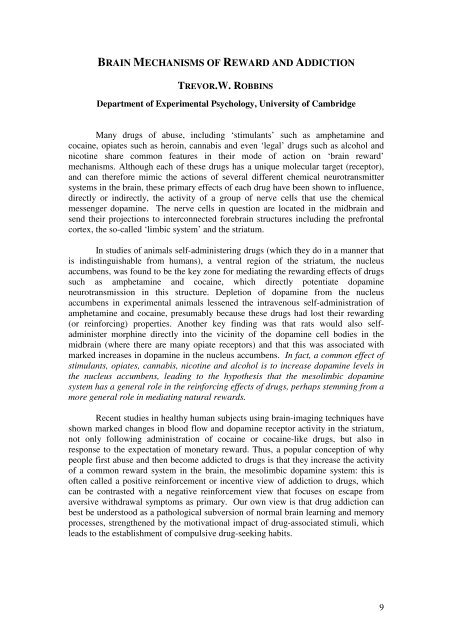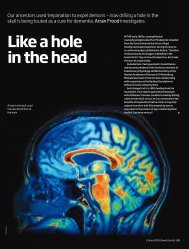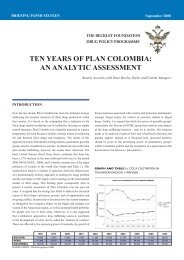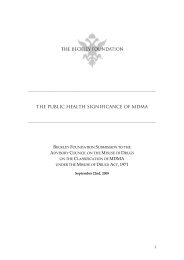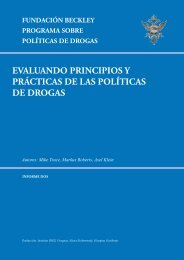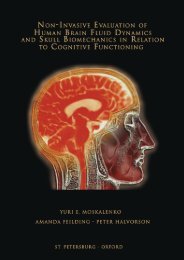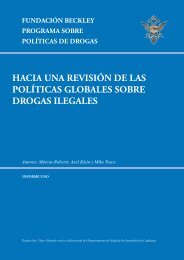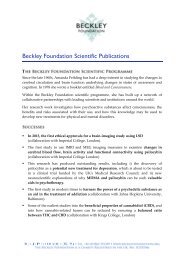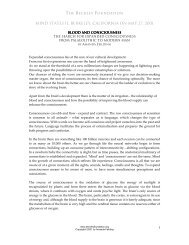Prof. Trevor Robbins – Brain Mechanisms of Reward and Addiction
Prof. Trevor Robbins – Brain Mechanisms of Reward and Addiction
Prof. Trevor Robbins – Brain Mechanisms of Reward and Addiction
You also want an ePaper? Increase the reach of your titles
YUMPU automatically turns print PDFs into web optimized ePapers that Google loves.
SUMMARY• Statistics for drug abuse in the UK suggest that cocaine <strong>and</strong> heroin represent agrowing problem. However, drug abuse is not a simple problem, <strong>and</strong> abuse <strong>of</strong>different drugs fluctuates from year to year. It is also difficult to categorise drugabuse precisely because polydrug abuse is the norm.• We underst<strong>and</strong> a good deal about how these <strong>and</strong> other drugs <strong>of</strong> abuse work in thebrain, mainly from experiments with animals.• In humans the animal data are confirmed by studies using brain-imagingtechniques.• There is probably a common 'reward system'which many, if not all, drugs <strong>of</strong>abuse appear to influence.• This reward system includes the nucleus accumbens <strong>and</strong> the release <strong>of</strong> thechemical messenger dopamine in this brain structure.• Drug abuse, addiction <strong>and</strong> dependence can be considered as aberrant forms <strong>of</strong>learning, possibly with distinct stages.• This aberrant learning is controlled by brain structures that interact with thenucleus accumbens such as the amygdala, hippocampus <strong>and</strong> prefrontal cortex.• The aberrant learning component <strong>of</strong> addiction also represents a target for noveltreatments (both pharmacological <strong>and</strong> psychological).CONCLUSION• Some areas <strong>of</strong> the brain, such as the nucleus accumbens, are sensitive to natural(food, sex), conditioned (money) <strong>and</strong> artificial (brain stimulation, drugs <strong>of</strong>abuse) rewards: i.e. drugs may usurp or hijack natural reward mechanisms.• Drugs with apparently different molecular actions may act on the mesolimbicdopamine pathway for their rewarding effects.• Central to underst<strong>and</strong>ing drug addiction is the question <strong>of</strong> how chronic drugexposure affects the brain <strong>and</strong> how it responds to this.• Conditioning mechanisms contribute importantly to addiction <strong>and</strong> these recruit<strong>and</strong> devolve control to other brain regions.importantly to addiction <strong>and</strong> these recruit <strong>and</strong> devolvecontrol to other10
Why are humans on the whole able to moderate other types <strong>of</strong> rewardingbehaviours, but <strong>of</strong>ten cannot control their compulsion to use drugs?The great majority <strong>of</strong> people can control their drug-taking, as they do with naturalrewards. Others have a lack <strong>of</strong> control even with natural rewards such as food <strong>and</strong>sex. Individual variability <strong>and</strong> genetic predisposition help to explain why some losecontrol. One brain region implicated in addiction is the frontal lobes that help toregulate the action <strong>of</strong> the nucleus accumbens. If people are impaired in frontal lobefunctioning to start with, there may be an increased probability <strong>of</strong> becoming addicted.However, the toxic effects <strong>of</strong> drugs may also target frontal areas <strong>and</strong>, therefore, drugsmay further enhance the drug-taking behaviour through degradation <strong>of</strong> controlmechanisms. Amphetamine addicts <strong>of</strong>ten have changes in the frontal cortex that areassociated with a loss <strong>of</strong> self-control.If both drug <strong>and</strong> natural reinforcers use the same reward pathways <strong>and</strong> involvelearning, how then can we erase only drug-related memories <strong>and</strong> not otheressential memories?Reconsolidation is the ability to reactivate memories using reminder cues. It may bepossible to activate certain memories using specific cues <strong>and</strong> then attempt to eliminatethese selectively, without damaging an otherwise essential reward system. Proteinsynthesis encodes <strong>and</strong> updates memories so we are able to remind a rat <strong>of</strong> a specificmemory <strong>and</strong> then give protein synthesis inhibitors only when that memory is active.In this way, it is possible to create amnesia for only the specific conditioned stimuli,leaving other reward stimuli intact.Could there be therapeutic uses for drug action?Rehearsing movements can increase plasticity in the brain <strong>and</strong> cause restitution <strong>of</strong>damaged areas <strong>and</strong>/or recruitment <strong>of</strong> adjacent areas after stroke or head injury. Drugscan strengthen the impact <strong>of</strong> rehearsed actions, so may be used therapeutically toincrease plasticity after damage. There is some evidence that amphetamines can helpstroke patients recover, enhancing the rewards gained when movements are rehearsed,<strong>and</strong> thus reinforcing behaviour.Illicit Drug Use in the UK: 2000.Drug No. <strong>of</strong> Users Annual Value PopularityCrack cocaine 210,000 £1,870m GrowingHeroin 295,000 £2,313m GrowingEcstasy 432,000 £294m StaticAmphetamines 967,000 £258m FallingCocaine* 476,000 £352m GrowingCannabis 3,100,000 £1,577m StaticTotal 5,480,000 £6.6bn*Use <strong>of</strong> Cocaine, 16-24 Year olds, up from 1 to 5% between 1994-2000Source “Drug misuse declared in 2000: Results from British Crime Survey” (Independent 22/9/2001)12
Neuron cell bodySynapse(Gap between nervecells)dendritesaxonreuptakedopaminetransporterreleasedopaminedopaminereceptorDopamine Action at the SynapsePreFrontalCortex(Frontal Lobe)CingulumNucleus Accumbensheroin, morphine,nicotineVentralTegmentalArea (VTA)cocaine, amphetamine,heroin, morphine,nicotine, cannabis,alcohol.AmygdalaMidbrain‘Mesolimbic’Dopamine NeuronsDopamine <strong>Reward</strong> Pathway Common to All Drugs13


